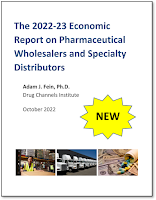I am pleased to announce our new
2022–23 Economic Report on Pharmaceutical Wholesalers and Specialty Distributors, available for purchase and immediate download.
We’re offering special discounted pricing if you order before October 21, 2022!
The 2022–23 Economic Report on Pharmaceutical Wholesalers and Specialty Distributors—our 13th edition— remains the most comprehensive, fact-based tool for understanding and analyzing the large and growing U.S. pharmaceutical distribution industry.
This 2022-23 edition contains the most current financial and industry data along with detailed information about the strategies and market positions of the largest companies: AmerisourceBergen, Cardinal Health, and McKesson. It updates our annual analysis of each wholesaler’s business segments and underlying business profitability, based upon our proprietary economic models.
The notable new material in this 2022-23 edition includes three new sections:
- Section 3.4.1. contains new data on hospital acquisitions and consolidation activity.
- Section 6.1.6. examines how the Inflation Reduction Act could ultimately impact pharmaceutical wholesalers’ customers and business outlook.
- We have updated our financial analyses based on the new reporting segments introduced by AmerisourceBergen and McKesson.
We also update sections that were introduced in recent editions, such as our estimates of wholesalers' profits from provider-administered biosimilar drugs.
If you would like to pay by corporate purchase order or check, please
email Tamra Feldman. If you preordered the report, you should have already received an email with download instructions.
Please contact us if you did not receive the email.
WHAT’S GOING ON
Twice a year, I spend my evenings and weekends writing
two comprehensive, fact-based, and nonpartisan reports on drug channel economics. In some small way, I try to make the world a better and smarter place.
Licenses for our DCI reports are regularly purchased by nearly every company involved in the drug channel: pharmaceutical manufacturers, wholesalers, pharmacists, pharmacy owners, hospitals, buyers, benefit managers, managed care executives, policy analysts, investors, lawyers, consultants, and more. So, you can find out what your customers, partners, and competitors are reading.
The 2022–23 Economic Report on Pharmaceutical Wholesalers and Specialty Distributors is the only resource of its kind available anywhere. It offers 142 proprietary charts, exhibits, and data tables.
FOUR FUN FACTS
- The 9 chapters are self-contained and do not need to be read in order. (Really!) There are loads of internal hyperlinks to help you navigate the document and customize it to your specific interests and priorities.
- We are offering the option to download an additional PowerPoint file with images of all 150 exhibits. This popular option helps you share the insights and data with others in your organization. (The exhibits appear in all license versions. The PowerPoint file option is available only with the purchase of a corporate license.)
- There are nearly 600 endnotes, most of which have hyperlinks to original source materials. These source materials offer a handy way to build your knowledge base beyond what’s included in the full report.
- As usual, I have reluctantly stripped out the corny jokes and pop culture references.
If you have any questions (before or after reading the report),
please email me.
Enjoy!




























